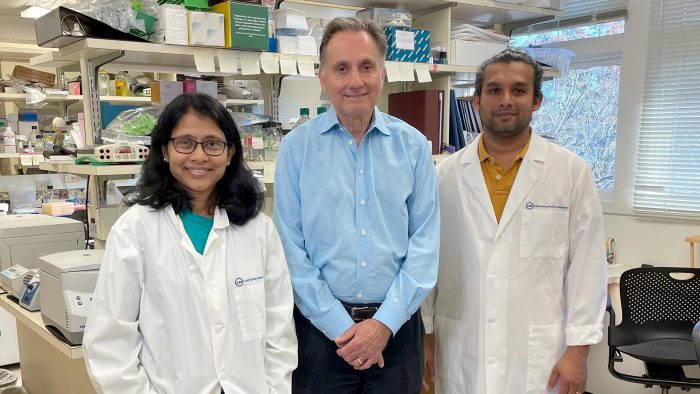In exploring cancer, CSHL’s Spector and postdocs make heart discoveries

By Daniel Dunaief
One came from India, the other from Sri Lanka. After they each earned their PhD’s, they arrived on Long Island within seven months of each other about seven years ago, joining a lab dedicated to studying and understanding cancer. Each of them, working on separate projects, made discoveries that may aid in the battle against heart disease.
Working for principal investigator David Spector at Cold Spring Harbor Laboratory, postdoctoral fellow Rasmani Hazra, who grew up in Burdwan, India, found a link between a gene that affects cancer in mice that also can lead to a problem with the development of heart valves.
Hazra worked with two long noncoding RNAs that are highly expressed in mouse embryonic stem cells, which have the ability to differentiate into many different types of cells.
Specifically, she found that mice that didn’t have Platr4 developed heart-related problems, particularly with their valves.
At the same time, postdoctoral fellow Gayan Balasooriya, who was born and raised in Sri Lanka, discovered that a single, non-sex gene is governed by different epigenetic mechanisms based on whether the gene is inherited from the mom or the dad.
While it was known that males are more susceptible to heart disease than females, researchers did not know which copy of the gene related to those diseases are expressed. This discovery could help in understanding the development of heart defects.
“Although we ended up at heart development” in both of these published studies, “we didn’t initiate” looking for heart-related information, said Spector. “The science led us there.
Spector, however, expects that the lessons learned about differentiation in the context of the developing heart can also “impact out knowledge about tumors” which he hopes will eventually lead to advances in how to treat them.
He added that any clinical benefit from this work would take additional research and time.
An on and off switch
In Hazra’s study, which was published in the journal Developmental Cell, she worked with Platr4 because humans have several possible orthologous genes.
When Platr4 expression, which shuts down after birth, is deleted from cells or embryos, the mice died from heart valve problems.
The human equivalent of Platr4 is located on chromosome 4. At this point, clinical case studies have connected the deletion of this chromosome to cardiac defects in humans.
Hazra said her project initially examined the function of these long non-coding sections of RNA. She was exploring how they affected differentiation. She found this link through in vitro studies and then confirmed the connection in live mice.
Spector explained that this work involved extensive collaborations with other researchers at Cold Spring Harbor Laboratory, including teaming up with researchers who can do electrocardiograms on mice and who can assess blood flow.
A shared mouse imaging resource also helped advance this research.
“One of the advantages of Cold Spring Harbor Laboratory is that we have over 10 shared resources, each of which specializes in sophisticated technologies that scientists can use on their own projects,” he said. Each lab doesn’t have to learn and develop its own version of these skills.
Hazra plans to continue to study other long noncoding RNA. She is also working on glioblastoma, which is a form of brain cancer.
Hazra plans to start her own lab next fall, when she completes her postdoctoral research.
Inactive gene
Balasooriya, meanwhile, published his research in the journal Nature Communications.
He used RNA sequencing to identify numerous genes. He also looked at whether the RNAs originated from the mom or dad’s genes in individual cells.
Also planning to start his own lab next fall, Balasooriya found changes that alter gene expression between the alleles from the mother and the father experimentally and through data mining approaches.
“What was most surprising in my studies is that [he identified] the gene from the father’s side and the mother’s side are regulated in a different manner,” Balasooriya said. “I’m interested in following up on that finding.”
The next step for him is to look not only at the heart, but, more broadly, at how monoallelic gene expression changes the way regulators affect development and disease.
“I want to do a deep dive to find out the mechanisms” involved in this expression of a single copy of the gene, Balasooriya said, which could provide ways to understand how to control the process.
In the long run, this kind of research could provide insights into ways to treat heart disease as well as other diseases like cancer and immune diseases.
Growing up in the North Western Province in Sri Lanka, Balasooriya was interested in math and science. After he finished his bachelor’s degree in biology in Sri Lanka, he earned a master’s in molecular biology at the University of Hertfordshire in England. He “got so excited about biology and exploring new fields” that he decided to pursue his PhD at the University of Cambridge, England.
After college, he worked in computer science for a while and realized he was not passionate about it, which encouraged him to do his master’s. The experience in computer science helped him with bioinformatics.
As for Spector, he is pleased with the work of both of his postdoctoral researchers. “This is what being a principal investigator is all about, having young people join your lab, sitting down with them, discussing a potential project, not really knowing where it’s going to go,” he said.
He described both members of his team as “extremely successful” who were able to make discoveries that they shared in prestigious journals. Balasooriya and Hazra both laid the groundwork to go and start their own careers.
“Seeing the fruits of their work is the most rewarding experience” as the leader of a lab, Spector said.






